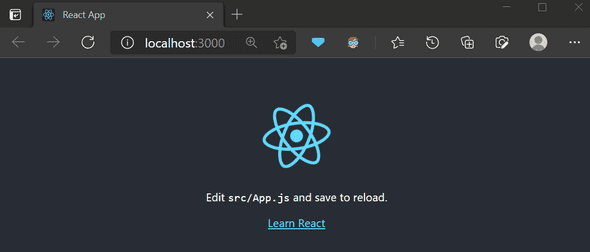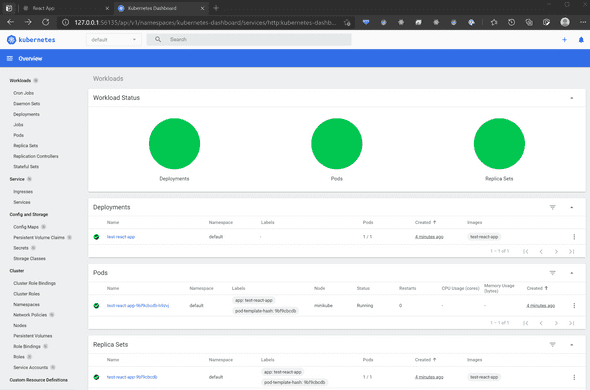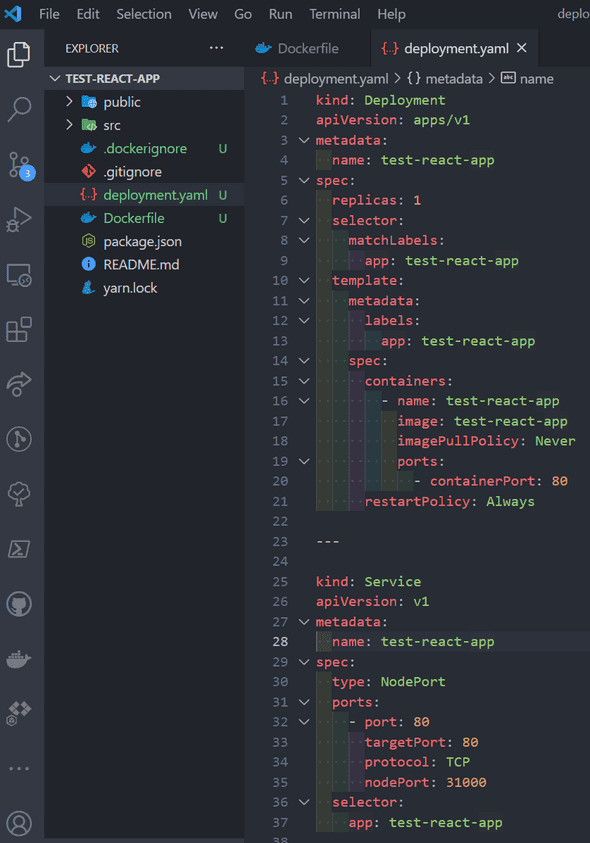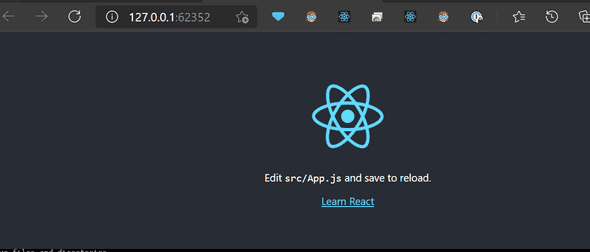Running a react app on Local Kubernetes cluster on Windows 10
16 March 2021
Prerequisites
Won't be covering the installation process of Docker Desktop and enabling the WSL2 backend here in this blog. Assumption is that readers can figure out the process from the given resources on their own. I might cover those topics in detail if there is enough demand in future blogs.
Make sure you are running Linux Containers Backend in Docker Desktop after installing it.
minikube start
minikube setups up a local kubernetes cluster for development on local host (in this case windows).
Since we will be using a local docker image and bypassing the need to push to a docker registry and then specifying the same during deployment on kubernetes, --insecure-registry=10.0.0.0/24 is used.
Why 10.0.0.0/24? Checkout
Run the following command to start the local kubernetes cluster in a powershell (preferably admin powershell)
minikube start --insecure-registry="10.0.0.0/24"
Sample Output
❯ minikube start --insecure-registry="10.0.0.0/24"
* minikube v1.18.1 on Microsoft Windows 10 Pro 10.0.21332 Build 21332
* Using the docker driver based on existing profile
* Starting control plane node minikube in cluster minikube
* Restarting existing docker container for "minikube" ...
* Preparing Kubernetes v1.20.2 on Docker 20.10.3 ...
* Verifying Kubernetes components...
- Using image kubernetesui/dashboard:v2.1.0
- Using image kubernetesui/metrics-scraper:v1.0.4
- Using image gcr.io/k8s-minikube/storage-provisioner:v4
* Enabled addons: storage-provisioner, dashboard, default-storageclass
* Done! kubectl is now configured to use "minikube" cluster and "default" namespace by default
Create React app
Make sure that node and npm are installed in the windows environment
❯ node -v
v15.11.0
❯ npm -v
7.6.3
Then use npx create-react-app test-react-app to create a test react application
❯ npx create-react-app test-react-app
Need to install the following packages:
create-react-app
Ok to proceed? (y) y
Creating a new React app in D:\work\test-react-app.
Installing packages. This might take a couple of minutes.
Installing react, react-dom, and react-scripts with cra-template...
yarn add v1.22.4
[1/4] Resolving packages...
[2/4] Fetching packages...
Finally check to see that app is running as expected

Configure minikube docker local environment
Run the following command to set the local configuration for making the development iteration easier by using the local docker images.
NOTE This stays local to your powershell terminal in which we run the following command
& minikube -p minikube docker-env | Invoke-Expression
For anyone curious, Run minikube docker-env to see the actual commands that are getting run
❯ minikube docker-env
$Env:DOCKER_TLS_VERIFY = "1"
$Env:DOCKER_HOST = "tcp://127.0.0.1:52175"
$Env:DOCKER_CERT_PATH = "C:\Users\Naren\.minikube\certs"
$Env:MINIKUBE_ACTIVE_DOCKERD = "minikube"
# To point your shell to minikube's docker-daemon, run:
# & minikube -p minikube docker-env | Invoke-Expression
Dockerize the react application
Simplest way to create a docker image of a react app is to add the following files to the root of the application folder (repository in case of git)
Dockerfile
FROM node:10-alpine as build-step
RUN mkdir /app
WORKDIR /app
COPY package.json /app
RUN npm install
COPY . /app
RUN npm run build
FROM nginx:1.17.1-alpine
COPY --from=build-step /app/build /usr/share/nginx/html
.dockerignore
/node_modules
/build
.git
*.md
.gitignore
Docker Build the image
docker build -t test-react-app .
Check for the built image
❯ docker images test-react-app
REPOSITORY TAG IMAGE ID CREATED SIZE
test-react-app latest e81a494ead2b About a minute ago 21.1MB
Kubernetes deployment
A deployment and service resources are required for deploying the react app on to the kubernetes cluster. We can combine both specifications in to single yaml file by separating them with ---
- Observe the
imagePullPolicyattribute marked as Never indicating that don’t look at docker registry for pulling theimagecalledtest-react-app - Also we will be using the simplest
servicecalledNodePortto map the node’s port in kubernetes cluster to applications port
deployment.yaml
kind: Deployment
apiVersion: apps/v1
metadata:
name: test-react-app
spec:
replicas: 1
selector:
matchLabels:
app: test-react-app
template:
metadata:
labels:
app: test-react-app
spec:
containers:
- name: test-react-app
image: test-react-app
imagePullPolicy: Never
ports:
- containerPort: 80
restartPolicy: Always
---
kind: Service
apiVersion: v1
metadata:
name: test-react-app
spec:
type: NodePort
ports:
- port: 80
targetPort: 80
protocol: TCP
nodePort: 32000
selector:
app: test-react-app
Deploy
We use kubectl apply -f <yaml> to deploy both the deployment and service
kubectl apply -f .\deployment.yaml
Sample Output
❯ kubectl apply -f .\deployment.yaml
deployment.apps/test-react-app created
service/test-react-app created
Check the pods running
Verify that there are pods running using kubectl get pods
❯ kubectl get pods
NAME READY STATUS RESTARTS AGE
test-react-app-9bf9cbcdb-h9zvj 1/1 Running 0 12s
Access the react app
Finding the Service URL
We use minikube to find out the service URL for the deployed react application
minikube service test-react-app --url
Sample Output
❯ minikube service test-react-app --url
🏃 Starting tunnel for service test-react-app.
|-----------|----------------|-------------|------------------------|
| NAMESPACE | NAME | TARGET PORT | URL |
|-----------|----------------|-------------|------------------------|
| default | test-react-app | | http://127.0.0.1:62352 |
|-----------|----------------|-------------|------------------------|
http://127.0.0.1:62352
❗ Because you are using a Docker driver on windows, the terminal needs to be open to run it.
Open the app in Browser
Local Kubernetes Dashboard
All the while we can see the effects of running any kubectl commands in the kubernetes local dashboard
minikube dashboard
Sample Output
❯ minikube dashboard
🔌 Enabling dashboard ...
▪ Using image kubernetesui/dashboard:v2.1.0
▪ Using image kubernetesui/metrics-scraper:v1.0.4
🤔 Verifying dashboard health ...
🚀 Launching proxy ...
🤔 Verifying proxy health ...
🎉 Opening http://127.0.0.1:56135/api/v1/namespaces/kubernetes-dashboard/services/http:kubernetes-dashboard:/proxy/ in your default browser...
will open the dashboard in a new tab

Cleanup
Cleanup the deployment and service using the following command
kubectl delete -f .\deployment.yaml
Close down minikube (local k8s cluster) and delete
minikube stop
minikube delete








